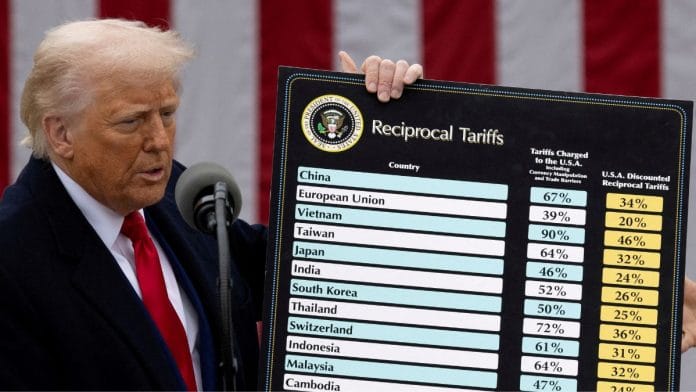New Delhi: US President Donald Trump’s decision to first impose and then pause ‘retaliatory tariffs’ on about 90 countries, including India, has led to upheaval in the global markets. On Wednesday, a week after the tariffs kicked in, Trump announced a 90-day pause for all countries except China.
The US hit China with the highest duty during its 2 April ‘Liberation Day’ announcements, which has since compounded to nearly 125 percent after a series of tit-for-tats in which Beijing increased its duty on US imports to 84 percent.
It was only Thursday that the stock markets rallied after Trump’s relief announcement.
While the tariffs were in effect, many countries reached out to Washington to negotiate some sort of an agreement. While Trump may want to claim this as a victory, analysts say ‘V’ actually stands for volatility right now. Over the last week, volatility indexes (VIX) across the world have surged, with the Chicago Board Options Exchange (CBOE) and the India VIX surging by 120 and 69 percent, respectively.
ThePrint explains what a volatility index, often called a ‘fear gauge,’ is and what leads to a high VIX.
Also Read: Trump’s reckless policies won’t be the end of the American era or its global leadership
What is a volatility index
A volatility index predicts and anticipates market movements in the near future, usually over a span of a month. A higher VIX indicates high volatility in the market and vice versa.
VIX, created by CBOE, was the first benchmark to quantify market expectations of volatility. But the index is forward-looking, which means that it only shows the implied volatility of the S&P 500 (SPX) for the next 30 days.
While the CBOE VIX only measures the US stock market, other major stock markets have their own VIX index. India VIX is one such example.
The India VIX, introduced in 2008, is calculated by the National Stock Exchange (NSE) using NIFTY option Order Book Data. This is based on the best bid-ask quotes for near and next-month NIFTY options contracts traded on the NSE’s Futures & Options (F&O) sector.
The computation of India VIX involves a sophisticated methodology adapted from the CBOE. It considers factors such as time to expiry, interest rates, forward index levels, and the bid-ask prices of NIFTY options contracts.
Behind the recent movements
This week, the CBOE VIX index soared by over 120 percent to reach 57.3 Wednesday. Similarly, the India VIX surged by nearly 69 percent in the past five days to touch 21.74 Thursday.
On 7 April, it was up nearly 65 percent at 23.18, the biggest intraday surge since June 2024.
In June last year, the India VIX surged nearly 44 percent in a single day after the results of the Lok Sabha elections were announced, signaling heightened investor anxiety.
While the VIX, this week, has reached its highest in ten months since June last year, it had previously risen by almost 64 percent in August 2015 during the global market upheaval.
The surge in the fear gauge was caused by a significant sell-off in the markets, which pulled equities indices down 5 percent during the day. The losses were caused by uncertainties over the impact of Trump’s high tariffs, which have prompted retaliatory measures from China, the world’s largest manufacturer by capacity and dollar value.
Risk assets have collapsed internationally after the 2 April statements, with certain emerging markets suffering the most since the late 1990s Asian Financial Crisis.
Experts believe that the fear index could further increase with the options premium rising.
What makes the volatility index move
Several elements can impact the movement of the index, primarily economic conditions.
Economic indicators like GDP growth rates, inflation, and employment figures can sway market expectations and volatility.
Similarly, global incidents like trade wars, geopolitical conflicts, or pandemics can introduce uncertainty, affecting volatility.
Other factors affecting the movement of the index include major corporate announcements of company performance that can lead to market adjustments, overall investor mood driven by news and rumors, and option trading activity.
Heightened tensions in the market usually lead to investors incurring losses during volatile periods.
(Edited by Sanya Mathur)
Also Read: Penguins, polar bears & tariffs: Trump’s trade war lands on ice with no one to tax but the wildlife






